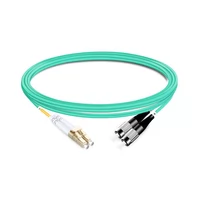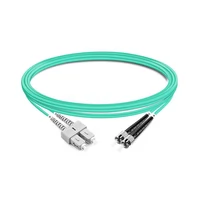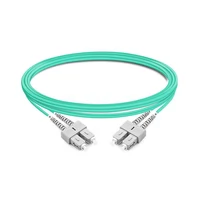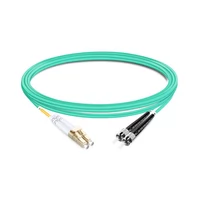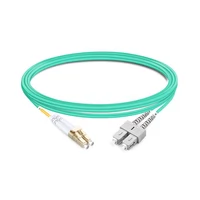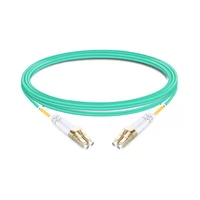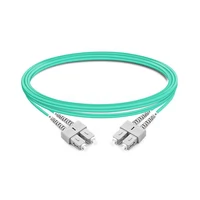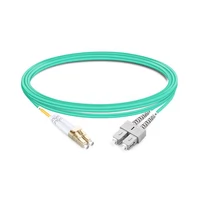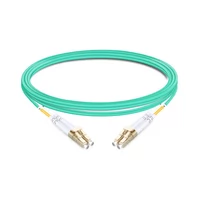In the world of data communications, OM4 fiber optic cables have become a key ingredient for high-speed network applications. These cables are built to satisfy the ever-increasing need for bandwidth and faster data transfer rates; therefore, they offer improved performance as well as efficiency. This write-up provides an extensive analysis of OM4 fiber optic cables by discussing their main features, uses, and technical breakthroughs that distinguish them from earlier versions. Whether you work as a network engineer or an IT expert or if you are just curious about fiber optics technology advancement, this manual was designed to give you all-rounded information regarding OM4 cables and their place in contemporary networking solutions.
Table of Contents
ToggleWhat is OM4 Fiber?

Understanding OM4 Multimode Fiber
OM4 multimode fiber is an optical fiber that was made for transmitting data at high speeds, particularly with laser-based equipment like Vertical-Cavity Surface-Emitting Lasers (VCSELs). What sets OM4 apart from other fibers is its core diameter, which measures 50 microns across, and the fact that it can handle bigger bandwidths over longer distances than its predecessors, such as OM3. With OM4, you can transmit data at 10Gbps for up to 550m or even get 40Gbps, and 100Gbps links supported up to 150m. This, therefore, makes it perfect for use in high-performance computing environments and data centers where fast operation is a must-have alongside reliability. Additionally, this fiber has a better modal bandwidth of about 4700 MHz·km, which ensures low signal distortion and error-free transmission of signals over long distances.
How OM4 Differs from OM3 Fiber
In many important technical respects, OM4 fiber optics are a step forward from OM3 fiber optics. For data transmission, both types of fibers have the same core diameter, which is 50 microns, and use VCSELs. However, there are major differences between them in terms of bandwidth and distance that can be covered.
Comparative Technical Parameters:
- Effective Modal Bandwidth (EMB):
- OM3: 2000 MHz·km
- OM4: 4700 MHz·km
- Data Transmission:
- 10 Gbps:
- OM3: up to 300 meters
- OM4: up to 550 meters
- 40 Gbps and 100 Gbps:
- OM3: up to 100 meters
- OM4: up to 150 meters
What Does OM4 Stand For?
Optical multimode 4 (OM4) is a category of fiber optic cables that fall under multimode. Such standards can transmit more significant amounts of data over more extended periods than previous versions. Here, “OM” means optical fiber intended for multiple modes of light transmission at once, while the number 4 represents its rank among other types in this series, such as OM1, OM2, and OM3. The reason why it was designed is that there has been an ever-increasing need for faster networks with greater bandwidths where computers are interconnected within close ranges like data centers used in high-performance computing environments so as to achieve higher speeds during data transfer between them; therefore, OM4 fiber was created according to these demands. What sets apart each generation from the next are improved distance capabilities alongside increased modal bandwidths – which greatly enhance its performance over longer distances.
How is OM4 Fiber Used?

Applications of OM4 Multimode Fiber
In high-speed data transmission settings, where bandwidth and distance are both important, OM4 multimode fiber is commonly used. Here are some of its main uses:
- Data Centers: In data center backbones that connect servers, storage systems, and networking equipment together, OM4 fiber is widely deployed. With high EMB rates over long distances which allow for quick movement of information packets ensuring efficient operation within the data centers.
- High-Performance Computing (HPC): OM4 fibers have very broad modal bandwidths which make them suitable for use in High Performance Computing environments where there is a need for strong and low latency communication links.
- Enterprise Networks: For connecting different branches or divisions within large enterprises so as to enable smooth communication flow across vast campuses or office parks; this is achieved through using OM4 fibers.
- Telecommunications: It supports various backbone infrastructures in telecommunications thus making it possible to transfer large amounts of information quickly over long distances needed by services such as internet connectivity, video conferencing among others provided through clouds.
Advantages of OM4 in 100G Networks
There are a number of key reasons why 100G network deployments should use OM4 fiber optic cables:
- Longer Distance Support: One hundred gigabits per second can be transmitted over 150 meters using OM4 fiber, which is greater than the 100-meter limit of OM3 fibers.
- Higher Modal Bandwidth: At 4700 MHz·km, OM4 has more than twice the modal bandwidth as its predecessor. This greatly reduces distortion caused by overlapping signals and makes it possible to transmit error-free data over longer distances.
- Cost Effectiveness: Using OM4 fibers may eliminate the need for signal repeaters or amplifiers required by other types of cabling systems. This can save money and simplify network architecture.
- Future Proofing: The improved characteristics of OM4 will allow networks that are based on it to easily keep up with higher speed requirements in the future without having to replace large amounts of cable infrastructure.
Deploying OM4 Fiber in Data Centers
To make sure that OM4 fiber works at its best in data centers, certain technical aspects have to be dealt with.
- Patch Panels and Connectors: The MPO/MTP connectors used should always be of high quality so as to minimize signal loss and ensure strong connections.
- Cable Management: Structured cabling practices ought to be implemented in order to keep the fiber pathways well-arranged and efficient which in turn decreases physical damage risk as well as preventing signal interference from occurring.
- Testing and Certification: Use Optical Time-Domain Reflectometers (OTDR) or any other necessary tools for thorough testing of the fiber links to certify that they meet performance standards after installation has been completed.
- Environmental Considerations: Data centers need proper environmental controls such as temperature regulation systems which are capable of maintaining consistent levels throughout different areas where these facilities may be located; humidity control systems are also required so that moisture does not destroy fibre optic cables that could result into loss or corruption of signals between devices connected together through these wires.
Adherence to such procedures enables data centres exploit fully OM4 fibre’s benefits for supporting high speed large capacity networks required by current computer needs.
What Are the Benefits of OM4 Fiber?
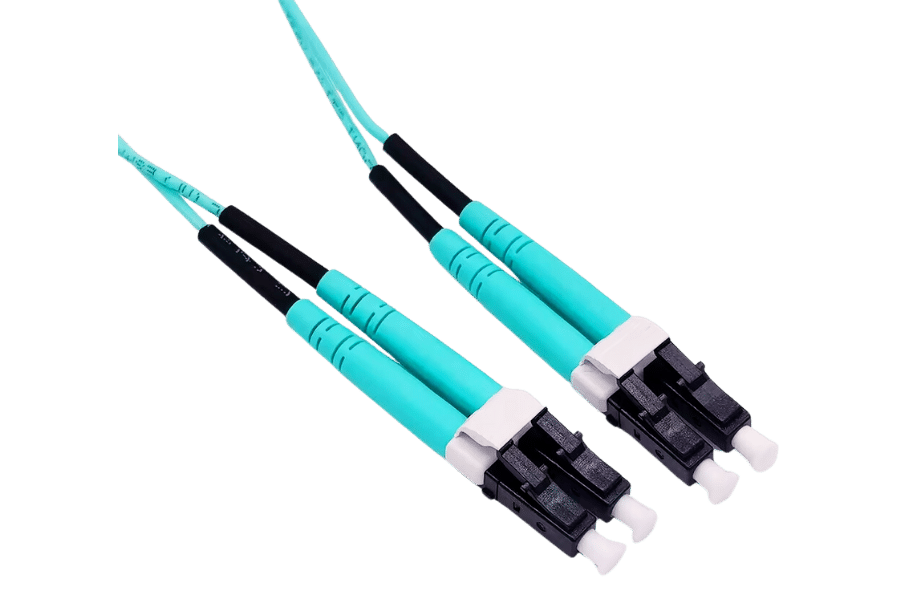
High Bandwidth Capabilities and Extended Reach
OM4 fiber is great for bandwidth because it can do 10 Gb/s, 40 Gb/s and 100 Gb/s Ethernet speeds over long distances. To be more precise, OM4 fiber allows for 10 Gb/s Ethernet to be transmitted across a distance of 550 meters, while 40 Gb/s and 100 Gb/s Ethernet can reach up to 150 meters. With these extended reach capabilities, large data centers and long-distance network architectures are best suited with the use of OM4.
Cost Savings
The enhanced performance of OM4 fiber could result in great savings:
- Less Active Equipment: This can transmit data over longer distances, so fewer repeaters and amplifiers are needed which saves money on capex and opex.
- Simpler Network Design: With less need for active components, the network architecture becomes simpler which can reduce the costs of installation and maintenance as well.
Technical Parameters Justification
- Core Diameter: 50 micrometers is the core diameter of OM4 fiber, which allows for fast optical communications.
- Modal Bandwidth: At 850 nm, OM4 fiber has an effective modal bandwidth of 4700 MHz*km that enables it to support extensive data transfers.
- Insertion Loss: By maintaining a typical insertion loss of less than 3.5 dB/km at 850 nm, OM4 fiber ensures that signals are transmitted efficiently.
In order to achieve high-speed data transmission and cost-effective network solutions, data centers should use OM4 fiber with these specifications.
How to Install and Maintain OM4 Fiber?

Installation Best Practices
To ensure the best performance and longest life of OM4 multimode fiber, keep these things in mind during installation:
- Connector Care: High-quality connectors should always be used and cleaned well before being installed to minimize connection losses.
- Bend Radius: The minimum bend radius of the fiber (which is typically 20 times the outer diameter of the cable) should not be violated. This means that for an OM4 cable, you must have a minimum radius of about 30 mm.
- Cable Handling: When installing, do not pull or stress too much on any part of it; there should also be appropriate equipment for handling cables so as to protect its fragile parts like splices and fibers, which can easily get damaged if not handled properly.
- Environmental Conditions: Ensure that temperature and humidity conditions are observed during this process because failure to comply may lead to deterioration or even destruction of optic-fiber installations due to adverse weather conditions such as high heat or moisture content.
- Documentation & Testing : After laying down new connections they must be documented followed by a comprehensive examination through OTDRs which sends an optical pulse into them then measures how light reflects back.
Maintenance
Cleansing OM4 fiber means you should clean, examine, and test it regularly to ensure that its performance remains high.
- Frequent cleansing: It is important to often use approved cleaning tools in order to prevent signal loss through cleaning connectors and couplers.
- Review: You should visually inspect connections and connectors using a fiberscope
- Periodic Testing: Carry out routine monitoring for attenuation levels with devices such as optical loss test set (OLTS) and OTDR which helps identify potential issues at their early stages.
Troubleshooting
Efficient troubleshooting requires recognizing and resolving issues that can affect the performance of the fiber.
- Identifying High Loss Events: Use OTDR to find events with high losses like bends, splices, or breaks.
- Signal Quality Issues: If there is a problem with signal quality, check for dirty or damaged connectors and clean them out or replace as needed.
- Connector and Splice Inspection: Inspect all connectors and splices for faults then fix them or substitute where necessary.
Technical Parameters Justification
To ensure that the best performance is achieved and effective troubleshooting can be done, it is important to know and comply with technical parameters:
- Center Diameter: This should be kept at 50 micrometers in order to enhance faster communications.
- Mode Bandwidth: The system should operate at a modal bandwidth of 4700 MHz*km at 850 nm so as to allow for high data rates over long distances.
- Loss of insertion: Keep track on insertion loss which should not exceed 3.5 dB/km at 850 nm to verify the effectiveness of signal transmission.
These are some installation, maintenance, and troubleshooting tips for extending the life span and optimizing OM4 multimode fiber networks in data centers.
What Are the Different OM4 Fiber Cable Types?

Plenum vs. Riser Rated OM4 Cables
It is important to know the dissimilarity between riser-rated and plenum-rated cables while choosing OM4 fiber cables for setup because of safety issues and conformity with the code.
Plenum Rated OM4 Cables
Cables rated for plenum use are made for being installed in plenum areas, which are spaces utilized for air circulation in heating and cooling systems. These types of cables have a jacket that is made from materials such as low-smoke and flame-resistant compounds to prevent fire propagation and toxicity. The following are the technical specifications:
- Flame retardant coating: This ensures that it meets the requirements set by NFPA 262 or UL 910.
- Low smoke emission: It reduces smoke released when burning takes place – very important in ventilation ducts.
Riser Rated OM4 Cables
Riser rated cables are created for vertical riser shafts that connect many floors in a building. These wires have a flameproof but not as strict a design as plenum cables. Technical requirements are the following:
Vertical flame spread resistance: meets UL 1666 and limits fire to a single floor.
Moderate smoke suppression: can be used in non-plenum areas of buildings.
Understanding Different Connectors: LC, SC, and MTP
LC Connectors
Small form factor connectors are what LC (Lucent Connector) connectors are. This makes them a perfect match for high-density connections in data centers today. Here are some important technical points about it:
Ferrule Diameter: It is 1.25mm wide so that it can align with precision and have low insertion loss.
Insertion Loss: < 0.3 dB per mated pair on average; this feature allows the signal to be transmitted efficiently.
SC Connectors
In telecommunications, push-pull design has made SC (Subscriber Connector) connectors a standard. Some of the key technical features are:
- Ferrule Diameter: 2.5mm, which allows for strong and secure connections
- Insertion Loss: Typically less than 0.25 dB per mated pair ensures reliability in connectivity.
MTP Connectors
The main features of Multi-fiber Termination Push-on connectors are as follows:
- Fiber Count: These connectors can accommodate 12 or 24 fibers in one connector, which makes them perfect for dense connections.
- Insertion Loss: This parameter usually falls below 0.35 dB per mated pair and allows for the transmission of large amounts of data at high speeds.
- Return Loss: More than 60 dB for single-mode (angled), thereby minimizing signal reflection.
Justification
Whether it is needed for quick backbone links or to save physical space in crowded areas, data centers can achieve peak efficiency by following these guidelines.
Conclusion
For data centers to work effectively and meet the requirements of the various standards, it is important that people know what separates riser rated OM4 cable from plenum rated ones and also get acquainted with different connector types. Every cable as well as connectors have their own benefits so it is necessary to select them depending on particular installation needs and technical specifications.
Reference sources
- Online Article – Network World
- Summary: Network World has produced a very detailed article about OM4 optical fiber wires with their features, performances and uses explained in depth. The article highlights that OM4 cables have more benefits than any other type as they are capable of carrying more data over shorter distances at higher speeds. In addition to this, the author touches on some structural aspects of these fibers, which enable them to work effectively within high-speed networks for transmitting large amounts of information between devices. This makes Network World’s publication reliable for IT experts who need such kind of knowledge in their field.
- Manufacturer Website – Corning Optical Communications
- Summary: Corning Optical Communications provides a comprehensive OM4 fiber optic cable guide on their website. The guide gives detailed information about the specifications, advantages and how to install OM4 cables. The fact that Corning is among top manufacturers in optical fiber solutions makes it certain that this resource is correct and useful for anyone who wants to deploy or improve their network with OM4 fibers.
- Academic Journal – IEEE Communications Magazine
- Summary: The article in the IEEE Communications Magazine is about the technical advancements and performance metrics of fiber optic cables OM4. This scientific journal provides an analysis on how well OM4 fibers cater for modern high-speed networks. It talks about what makes up an om4 cable, tests that were done on it, and also compares with other types of fibers, which give good knowledge-based information that can be used by professionals or any person undertaking research in telecommunication studies.
Frequently Asked Questions (FAQs)

Q: What does OM4 fiber optic cable refer to?
A: OM4 fiber optic cable refers to a kind of multimode fiber that has been optimized so that it can operate at higher data rates with longer distances thus offering more bandwidth, typically 40G and 100G used in high-speed network applications within data centers as well as enterprise networks.
Q: How is OM4 fiber different from other types of fibers?
A: OM4 fibers are designed for superior performance compared to OM1, OM2, or even OM3 fibers. The major benefit is the support for higher data rates over extended periods; for instance, while an OM3 cable supports 100G up to 100 meters (m), an equivalent length of the same specification can transmit 100G over a distance of 150 meters.
Q: What installations are ideal candidates for employing OM4 cables?
A: High-speed data networks within storage area networks (SANs), building backbones, and other applications that demand fast and reliable high-bandwidth performances are the best places where one should use OM4 fiber optic cables.
Q: How do OFNR and OFNP ratings differ from each other in relation to their application on OM4 cables?
A: These two classifications indicate what part of a building they should be used in. OFNR stands for Optical Fiber Nonconductive Riser while OFNP means Optical Fiber Nonconductive Plenum. If you have riser spaces, then choose OFNR, but if you have plenum areas, then go for OFNP because they have stricter fire safety requirements than their counterparts.
Q: What does “laser-optimized” mean when talking about OM4 cables?
A: When we say laser-optimized here, all it means is that these particular types of wires have been engineered such that they work best with lasers, especially those used in high-speed vertical cavity surface emitting (VCSEL) devices, which results in increased throughput rates as well as better overall system performance.
Q: Will MPO connectors work with OM4 fiber optic cables?
A: Yes it will. In data centers with high capacity for quick start up and efficient installation, MPO connectors permit connection of many fibers usually 12 or 24.
Q: What differentiates 100G OM4 fiber optic cables?
A: They can cover up to 150 meters while offering high bandwidths hence designed specifically for 100-gigabit Ethernet applications this is what makes them different from others.
Q: Do single-mode fibers support OM4 fiber optic patch cables?
A: No they don’t. Single mode fibers are designed for long distance communication and have different performance levels, connectors and distance specs as compared to multimode fibers such as OM4 which is created for short range communications like within a building or campus network.
Q: By what means do OM4 fibers outperform other multimode fibers?
A: Higher bandwidth of the core that is 50um wide combined with laser-optimized design enables these types of multi-mode fibres to achieve better results than any other type
Q: What are some typical uses for OM4 fiber optic patch cords?
A: For those who need fast, reliable connection speeds between devices situated in different areas but still want them connected via wire connections, then this device should be used without fail.
Related Products:
-
 1m (3ft) Duplex OM4 Multimode LC UPC to FC UPC PVC (OFNR) Fiber Optic Cable
$2.90
1m (3ft) Duplex OM4 Multimode LC UPC to FC UPC PVC (OFNR) Fiber Optic Cable
$2.90
-
 1m (3ft) Duplex OM4 Multimode SC UPC to ST UPC PVC (OFNR) Fiber Optic Cable
$3.00
1m (3ft) Duplex OM4 Multimode SC UPC to ST UPC PVC (OFNR) Fiber Optic Cable
$3.00
-
 1m (3ft) Duplex OM4 Multimode SC UPC to SC UPC PVC (OFNR) Fiber Optic Cable
$3.00
1m (3ft) Duplex OM4 Multimode SC UPC to SC UPC PVC (OFNR) Fiber Optic Cable
$3.00
-
 1m (3ft) Duplex OM4 Multimode LC UPC to ST UPC PVC (OFNR) Fiber Optic Cable
$3.00
1m (3ft) Duplex OM4 Multimode LC UPC to ST UPC PVC (OFNR) Fiber Optic Cable
$3.00
-
 1m (3ft) Duplex OM4 Multimode LC UPC to SC UPC PVC (OFNR) Fiber Optic Cable
$3.00
1m (3ft) Duplex OM4 Multimode LC UPC to SC UPC PVC (OFNR) Fiber Optic Cable
$3.00
-
 1m (3ft) Duplex OM4 Multimode LC UPC to LC UPC PVC (OFNR) Fiber Optic Cable
$3.00
1m (3ft) Duplex OM4 Multimode LC UPC to LC UPC PVC (OFNR) Fiber Optic Cable
$3.00
-
 1m (3ft) Duplex OM4 Multimode SC UPC to SC UPC OFNP Fiber Optic Cable
$3.10
1m (3ft) Duplex OM4 Multimode SC UPC to SC UPC OFNP Fiber Optic Cable
$3.10
-
 1m (3ft) Duplex OM4 Multimode LC UPC to SC UPC OFNP Fiber Optic Cable
$3.10
1m (3ft) Duplex OM4 Multimode LC UPC to SC UPC OFNP Fiber Optic Cable
$3.10
-
 1m (3ft) Duplex OM4 Multimode LC UPC to LC UPC OFNP Fiber Optic Cable
$3.10
1m (3ft) Duplex OM4 Multimode LC UPC to LC UPC OFNP Fiber Optic Cable
$3.10
-
 1m (3ft) Duplex OM4 Multimode SC UPC to SC UPC LSZH Fiber Optic Cable
$3.10
1m (3ft) Duplex OM4 Multimode SC UPC to SC UPC LSZH Fiber Optic Cable
$3.10
-
 1m (3ft) Duplex OM4 Multimode LC UPC to SC UPC LSZH Fiber Optic Cable
$3.10
1m (3ft) Duplex OM4 Multimode LC UPC to SC UPC LSZH Fiber Optic Cable
$3.10
-
 1m (3ft) Duplex OM4 Multimode LC UPC to LC UPC LSZH Fiber Optic Cable
$3.10
1m (3ft) Duplex OM4 Multimode LC UPC to LC UPC LSZH Fiber Optic Cable
$3.10

